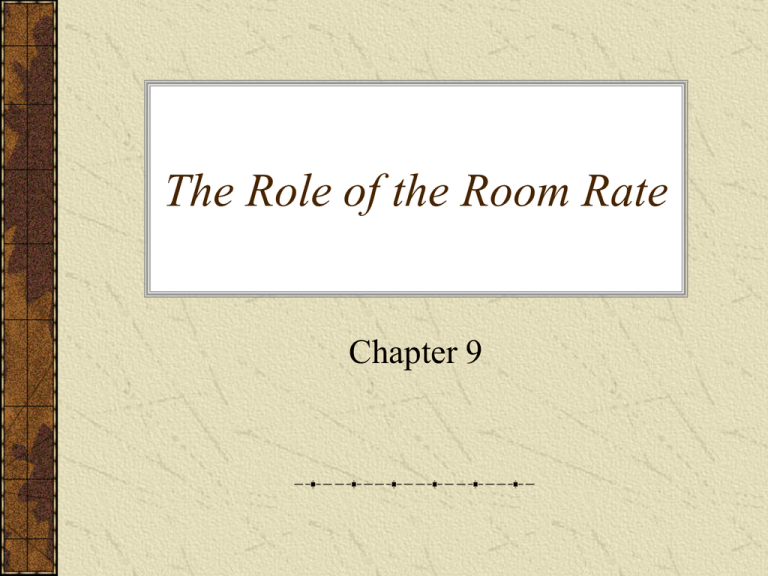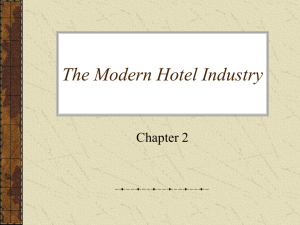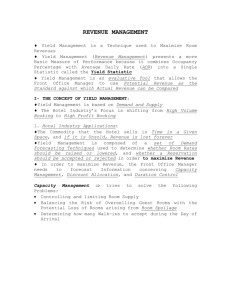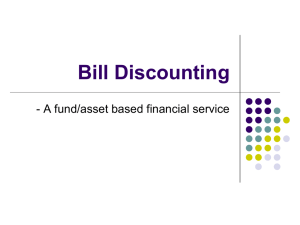The Role of the Room Rate - Resource Sites
advertisement

The Role of the Room Rate Chapter 9 THE ROOM RATE’S IMPACT ON GUEST DEMAND Room rates communicate a great deal about a hotel. Higher than average rates indicate a well-run property. The rate of growth in room prices has held roughly steady at 5.8% per year for more than 30 years. Hotel Room Demand Today, there are more hotel rooms available in the U.S. than ever before, but room demand is higher than ever before too. Unique, because no matter what direction the nation’s economy, room rates continue to rise. Competition Differences in both the physical facilities and the range of services offered justify higher rates than the competition. The condition of the facilities can offset their competitive advantage. “Clean and neat” sends an important subliminal message. Differences in service are more difficult to discern, but they add to the room rate as substantially as other components. Room rate elasticity Elasticity is defined as the change in demand (rooms sold) resulting from a change in price (room rates). Elasticity of demand for hotel rooms is complex. Hotels experience different degrees of elasticity throughout the year. Elasticity of lodging taxes One rate component over which hotel managers have little or no control is local lodging taxes. Antagonists of the hotel tax believe it is wrong to charge out-of-town visitors for city services that are not tourism related. Studies have demonstrated that an increased lodging tax may actually hurt the local economy. Dynamic pricing in negotiated corporate rates Corporate travel managers often negotiate favorable rates for their corporate travelers. Some of the questions corporate travel managers are asking about dynamic pricing include: – Will the dynamic pricing discount include all rooms types in the hotel? – Will the discount apply across all expenses for the trip, including breakfast, internet access…? – Will the rate fluctuate by night for a multi-night stay? – Will there be a floor or ceiling limiting how low or high the rate can fluctuate? Discounts off Rack Rate All hotels have a rack rate against which other pricing structures are designed. A hotel’s rack rate is the quoted, published rate that is theoretically charged to full paying customers. The rack rate is the full retail rate. Proof of discounting is most evident in the average daily rate computation. The discounting dilemma In markets where discounting is rampant, the only sure winner is the customer who buys a quality product for a fraction of the price. After becoming accustomed to discounted rates, customers perceive full rates as very poor value. Discounting profitability: both parties are happy—the guest pays less for the room and the hotel makes a higher profit from having created more room demand. However, rate discounting has a negative side as well, a 10% rate discount requires occupancy to rise to 66.67% in order to gross the same revenues as previously earned. Rate cutting: Rate cutting functions in an inelastic market. Rate cutting aims at the guest already staying in a competitor’s hotel across the street. Competitors, who lose business, counter with rate cuts, and the price war is on. For once sold at a lower rate, it is almost impossible to get the buyer to pay the original price. Examples of discounted rates Discounted or special rates come in a variety of shapes and sizes. Seasonal rates: Season and off-season rates are quoted by most resort hotels, with incremental increases and decreases coming as the season approaches and wanes. Weather-related discount: Credits or discounts against the rate are offered guests for each day it rains or stays unseasonably cool. Weekly rates: which are less than seven times the daily rate. Corporate rates: by guaranteeing a number of room-nights per year, the corporation negotiates a better rate, a corporate rate, from the hotel chain. Commercial rates: are the small hotel’s answer to corporate rates, smaller hotels make arrangements with small commercial clients. Government per-diems: Federal, state, and local governments reimburse traveling employees up to a fixed dollar amount. Difficulties may arise when the per-diem guest encounters the desk. Some chains accept the government rates, but individual properties may not. Employee courtesy rates: most hotel chains extend special rates to their employees when they travel within the chain. It pays to pay rack rate: although not really a discount, some upscale chains are experimenting with added perks for guest who actually pay full rack rate. Senior citizen rate: people over the age of 50 are the best money savers. They love to travel, and they’re careful with money. Infinite other discounts: there are an unlimited number of additional rate discounting possibilities. For instance: by providing members with deep discounts for traveling during off-peak periods, such clubs provide a win-win-win product. Auction travel sites: auctioning is a form of discounting that has gained popularity with the individual traveler. To qualify for deep discounts, travel auction companies often require a degree of flexibility on the part of the customer (non-prime-time flight schedules and less popular travel dates are the norm). Complimentary rooms Hotel managers should be as reluctant to give away complimentary (comp) rooms as automobile sales managers are to give away free cars. Comp are used for business promotion, as charitable giveaways, and as perks. Posting the comp: some casino hotels have the comp paid by a paper transfer to another department. The department manager has accountability, and the amount of comps appear on that departmental budget. Additional Rate Factors Energy, Resort Fees and Other Non-room Surcharges: swimming pool towels, inroom coffee, fax machine usage, administrative fee, etc. Double Occupancy: double occupancy refers to the use of the room by a second guest. Traditional rules increased the single-occupancy rate by a factor whenever the room was double-occupied. Time is Money While the actual date of arrival and departure is the primary consideration for establishing the guest charge, the number of hours of occupancy may someday play more of a role in rate determination than it does today. Day Rate Rooms: special rates exist for stays of less than overnight. These are called part-day rates, day rates, or sometimes use rates. Day rate guests arrive and depart on the same day. DETERMINING THE PROPER ROOM RATE Traditional Rate Calculations: – – – – The Hubbart Room Rate Formula The Building Cost Room Rate Formula The Ideal Average Room Rate Upselling Premium Accommodations











